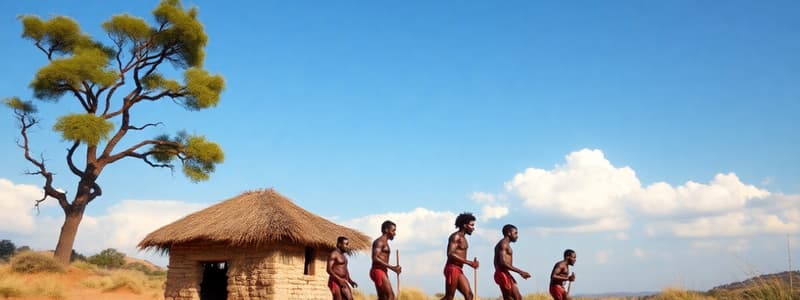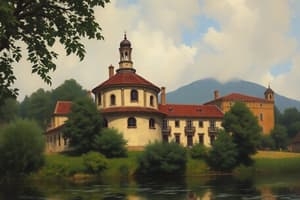Podcast
Questions and Answers
Which advantage did Homo sapiens have over Neanderthals in tool-making?
Which advantage did Homo sapiens have over Neanderthals in tool-making?
- More efficient ambush hunting with handheld tools
- Preference for hunting large predators
- Tools limited to close-range hunting
- Better projectile weapons for safer hunting (correct)
Neanderthals had a flexible diet with a wide variety of prey, which helped them survive environmental shifts.
Neanderthals had a flexible diet with a wide variety of prey, which helped them survive environmental shifts.
False (B)
What limitation in their diet made Neanderthals more vulnerable during environmental shifts?
What limitation in their diet made Neanderthals more vulnerable during environmental shifts?
Heavy reliance on large mammals
Homo sapiens' ability to use __________ weapons allowed for more effective hunting over Neanderthals' close-range tools.
Homo sapiens' ability to use __________ weapons allowed for more effective hunting over Neanderthals' close-range tools.
Match the following concepts with their corresponding descriptions:
Match the following concepts with their corresponding descriptions:
Which law requires museums to inventory Native American remains and consult with affiliated tribes?
Which law requires museums to inventory Native American remains and consult with affiliated tribes?
What is the main purpose of the National Historic Preservation Act (NHPA) Section 106?
What is the main purpose of the National Historic Preservation Act (NHPA) Section 106?
___ is the relationship of shared group identity, as defined by NAGPRA, which links current tribes to ancestral remains.
___ is the relationship of shared group identity, as defined by NAGPRA, which links current tribes to ancestral remains.
The ___ phase of CRM archaeology involves determining the importance and eligibility of a site for preservation or further excavation.
The ___ phase of CRM archaeology involves determining the importance and eligibility of a site for preservation or further excavation.
The official register of important historical sites is known as the ___ __ ___ ___.
The official register of important historical sites is known as the ___ __ ___ ___.
The primary weapon used by Neanderthals was projectiles.
The primary weapon used by Neanderthals was projectiles.
What was Shipman's hypothesis regarding Neanderthal extinction?
What was Shipman's hypothesis regarding Neanderthal extinction?
Match the following CRM terms with their definitions:
Match the following CRM terms with their definitions:
What did ancient DNA studies at Pueblo Bonito reveal about social organization in Chaco Canyon?
What did ancient DNA studies at Pueblo Bonito reveal about social organization in Chaco Canyon?
Which factor contributed significantly to the collapse of the Chaco civilization?
Which factor contributed significantly to the collapse of the Chaco civilization?
What is one characteristic of the post-Chaco Pueblo communities?
What is one characteristic of the post-Chaco Pueblo communities?
In Chaco Canyon, great houses like _______ served as centers for storage, ritual, and redistribution.
In Chaco Canyon, great houses like _______ served as centers for storage, ritual, and redistribution.
Kivas were primarily used for agricultural activities in Pueblo culture.
Kivas were primarily used for agricultural activities in Pueblo culture.
What climatic change occurred after AD 1000 that benefited the Chaco Canyon's agriculture?
What climatic change occurred after AD 1000 that benefited the Chaco Canyon's agriculture?
Match the following terms with their respective descriptions:
Match the following terms with their respective descriptions:
What happened to elites in Chaco Canyon as resources became scarce?
What happened to elites in Chaco Canyon as resources became scarce?
Which of the following best describes Graeber and Wengrow's idea of 'carnival parade of forms'?
Which of the following best describes Graeber and Wengrow's idea of 'carnival parade of forms'?
In Çatalhöyük, what was the purpose of 'History Houses'?
In Çatalhöyük, what was the purpose of 'History Houses'?
Which feature of Çatalhöyük suggests a connection to ancestral memory?
Which feature of Çatalhöyük suggests a connection to ancestral memory?
Graeber and Wengrow's 'carnival parade of forms' suggests that early cities could be both ______________ and hierarchical.
Graeber and Wengrow's 'carnival parade of forms' suggests that early cities could be both ______________ and hierarchical.
The concept of the ______________ effect describes how societies become resistant to change once they adopt complex structures, such as centralized governance or agriculture.
The concept of the ______________ effect describes how societies become resistant to change once they adopt complex structures, such as centralized governance or agriculture.
______________ were communal structures in Çatalhöyük with significant burials and decorations, serving as focal points for ritual activities and family memory.
______________ were communal structures in Çatalhöyük with significant burials and decorations, serving as focal points for ritual activities and family memory.
Çatalhöyük is considered the first city, or proto-city, starting around 7500 BC.
Çatalhöyük is considered the first city, or proto-city, starting around 7500 BC.
Match the following terms with their correct descriptions:
Match the following terms with their correct descriptions:
What time period is known as the Viking Age?
What time period is known as the Viking Age?
Which concept from Neil Price's Children of Ash and Elm suggests a reassessment of the Vikings?
Which concept from Neil Price's Children of Ash and Elm suggests a reassessment of the Vikings?
What role did Viking raids play in their society beyond mere violence?
What role did Viking raids play in their society beyond mere violence?
What significant event is marked by the Viking raid on Lindisfarne in AD 793?
What significant event is marked by the Viking raid on Lindisfarne in AD 793?
The Vikings spoke _______ and made inscriptions in runes.
The Vikings spoke _______ and made inscriptions in runes.
Viking raids were solely aimed at acquiring new territories.
Viking raids were solely aimed at acquiring new territories.
Match the following Viking-related terms with their descriptions:
Match the following Viking-related terms with their descriptions:
What was a major influence on Viking expansion during the Viking Age?
What was a major influence on Viking expansion during the Viking Age?
Flashcards
National Historic Preservation Act (NHPA) Section 106
National Historic Preservation Act (NHPA) Section 106
Requires federal agencies to consider the impact of their actions on historic properties, helping to protect them.
NAGPRA
NAGPRA
Law requiring museums to inventory Native American human remains and consult with affiliated tribes.
Cultural Affiliation (NAGPRA)
Cultural Affiliation (NAGPRA)
Shared group identity linking current tribes to ancestral remains.
CRM Archaeology: Evaluation Phase
CRM Archaeology: Evaluation Phase
Signup and view all the flashcards
National Register of Historic Places (NRHP)
National Register of Historic Places (NRHP)
Signup and view all the flashcards
Human Remains (NAGPRA)
Human Remains (NAGPRA)
Signup and view all the flashcards
Funerary Objects (NAGPRA)
Funerary Objects (NAGPRA)
Signup and view all the flashcards
Invasive Species (Human)
Invasive Species (Human)
Signup and view all the flashcards
Neanderthal dietary rigidity
Neanderthal dietary rigidity
Signup and view all the flashcards
Homo sapiens dietary flexibility
Homo sapiens dietary flexibility
Signup and view all the flashcards
Neanderthal toolmaking limitation
Neanderthal toolmaking limitation
Signup and view all the flashcards
Wolf-dog symbiosis benefit
Wolf-dog symbiosis benefit
Signup and view all the flashcards
Homo sapiens projectile weapons advantage
Homo sapiens projectile weapons advantage
Signup and view all the flashcards
Matrilineal Lineage
Matrilineal Lineage
Signup and view all the flashcards
Chaco Collapse
Chaco Collapse
Signup and view all the flashcards
Kiva
Kiva
Signup and view all the flashcards
Pueblo Bonito
Pueblo Bonito
Signup and view all the flashcards
Chaco Canyon Collapse - Cause
Chaco Canyon Collapse - Cause
Signup and view all the flashcards
Post-Collapse Practices
Post-Collapse Practices
Signup and view all the flashcards
Great Houses
Great Houses
Signup and view all the flashcards
Chaco Canyon (AD 1000-1150)
Chaco Canyon (AD 1000-1150)
Signup and view all the flashcards
Graeber and Wengrow's idea
Graeber and Wengrow's idea
Signup and view all the flashcards
Çatalhöyük History Houses
Çatalhöyük History Houses
Signup and view all the flashcards
Çatalhöyük ancestral memory
Çatalhöyük ancestral memory
Signup and view all the flashcards
Ratchet Effect
Ratchet Effect
Signup and view all the flashcards
Early cities
Early cities
Signup and view all the flashcards
Çatalhöyük
Çatalhöyük
Signup and view all the flashcards
Egalitarian city structure
Egalitarian city structure
Signup and view all the flashcards
Viking Age
Viking Age
Signup and view all the flashcards
Viking Age Dates
Viking Age Dates
Signup and view all the flashcards
Viking Raids' Purpose
Viking Raids' Purpose
Signup and view all the flashcards
Children of Ash and Elm
Children of Ash and Elm
Signup and view all the flashcards
Viking Society Diversity
Viking Society Diversity
Signup and view all the flashcards
Viking Age Beginnings
Viking Age Beginnings
Signup and view all the flashcards
Lindisfarne Raid
Lindisfarne Raid
Signup and view all the flashcards
Viking Settlement vs. Raids
Viking Settlement vs. Raids
Signup and view all the flashcards
Viking Sources Limitations
Viking Sources Limitations
Signup and view all the flashcards
Study Notes
Cultural Resource Management (CRM)
- Key Laws: National Historic Preservation Act (1966), NAGPRA (1990), National Register of Historic Places (NRHP) criteria
- NAGPRA (1990): Identifies shared group identity linking current tribes to ancestral remains. Examples include Kennewick Burial Case and phases of CRM Archaeology (survey, evaluation, data recovery). Categorizes remains as human remains, funerary objects, sacred objects, and objects of cultural patrimony
- National Historic Preservation Act (NHPA) Section 106: Requires federal agencies to consider the impact of their actions on historic properties, including protection of Native American religious practices.
- Archaeological Resources Protection Act: Law that requires museums to inventory Native American remains and consult with affiliated tribes.
Invaders (Neanderthals and Humans)
- Shipman's hypothesis: Humans outcompeted Neanderthals in a period of climate change, with a potential partnership with wolf-dogs.
- Predictions: Extreme cold/fluctuations, ambush predators (Neanderthals) vs. projectiles and distance running (Humans)
- Human advantages: Projectile weapons increased hunting efficiency over Neanderthal handheld tools. Dietary flexibility vs. Neanderthal dietary rigidity. Humans had a smaller percentage of Neanderthal genome. Carrying capacity limits, higher basal metabolic rates (BMR) in Neanderthals, compared to humans
Anasazi America (Chaco Canyon)
-
Jemez Pueblo Study: Indigenous forest management practices examined in Chaco Canyon, AD 1000-1150
-
Matrilineal Lineage: Lineage passed down through mother's line, a significant aspect of Pueblo culture.
-
Collapse of Chaco Canyon: Factors include environmental stress (climate change, drought), over-reliance on external resources, and reliance on centralized power.
-
Post-collapse Communities: Developed sustainable agricultural practices, cooperation, and kinship-based governance.
Cities
- Graeber and Wengrow's "Carnival Parade of Forms": Concept that early cities were both egalitarian and hierarchical, challenging the traditional linear model of social evolution.
- Rattchet Effect: Societies become resistant to change after adopting complex structures.
- Çatalhöyük: Example of an early city in Turkey (7500 BC) with no temples or palaces, but evidence of egalitarianism
- History Houses: Community meeting places in Çatalhöyük, with burials and decorations
- Social Transformations Vs. Collapse: Cities had various forms, ranging in civic unity, presence of temples and palaces. Various social organization and transformations.
Vikings
- Viking Age: AD 750-1050.
- Inscriptions: Vikings used runes, spoke Old Norse and were eventually converted to Christianity
- Raiding: Vikings conducted raids for wealth, marriage, and political competition, but these were not solely violent. In addition, the raids were sometimes a means to improve social standing and political power, as evident in economic policy
Studying That Suits You
Use AI to generate personalized quizzes and flashcards to suit your learning preferences.




